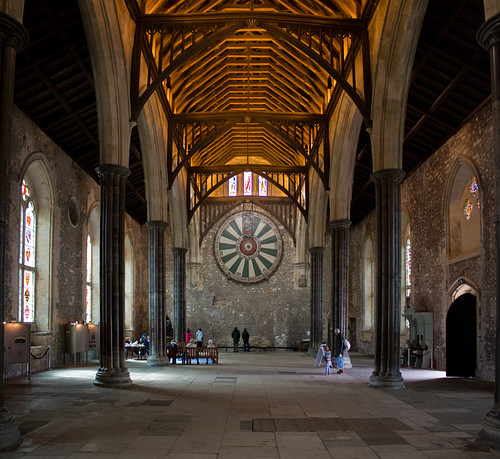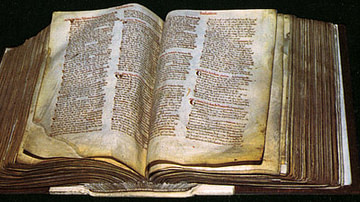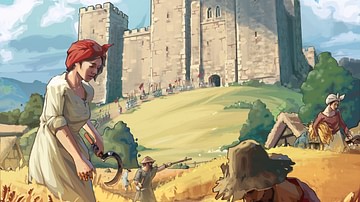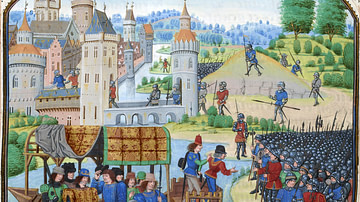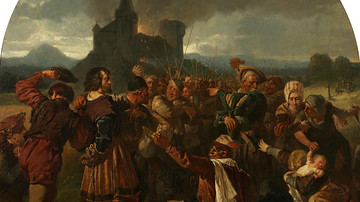
Medieval European Manorialism (Manorial System) was the system where rural society was arranged around a manor house or castle on an estate. The smallest units of these estates were called manors. Free and unfree labourers here worked the owner or tenant’s land in return for protection and the right to work a separate piece of land for their own needs.
The hub of these rural communities was the manor or castle – the estate owner's private residence and place of communal gatherings for purposes of administration, legal matters and entertainment. Regulations, customs and traditions varied from one estate to another and over time, but the system of manorialism persisted throughout most of the Middle Ages. Manorialism is not to be confused with feudalism which generally refers to the lord and vassal relationship between different levels of the aristocracy where land was exchanged for military service.
Origins
The idea of people of different social levels living together on a single estate for mutual benefit goes back to Roman times when countryside villas produced foodstuffs on their surrounding land. As the Roman Empire declined and foreign raids and invasions became more common, the security of living together in a protected place had distinct advantages. When this system was adopted on estates which the Frankish kings gave out to reward loyal nobles in the 8th century, medieval manorialism was born in Europe. The Frankish kings distributed parcels of land, known as benefices, in order to receive military service in return. Likewise, the lord of an estate gave the right to live and work on his land to the peasantry in return for their labour service. Peasants were either free or unfree, the latter category evolving from the slaves of the old Roman Empire. Manorialism, which already existed in some form under the Anglo-Saxons, became more developed and widespread in England following the Norman Conquest of 1066.
From the mid-11th century CE the system of feudalism spread across Western Europe where a lord-and-vassal relationship developed: lords gave the right to use and keep an income from a portion of their land to a vassal who promised military service in return. In the same manner, a vassal could then give a part of his land to another person in return for service which could be military or payment of goods in kind or even rent. Thus a hierarchy developed as land was parcelled out into ever smaller pieces with a tenant at each level. The smallest unit was the manor (also the name of its principle residential building). A manor estate might cover as little as a few hundred acres, which was just about enough land to meet the needs of those who lived on it, but the majority of manors were really more like small villages. Manors could be owned by the monarch, aristocrats or the church, and the very rich could own several hundred manors, collectively known as an 'honour'.
The Manor
Manors or large country houses (called villae or curtes in medieval continental Europe), have been built since villages started to be formed in the Neolithic period. As centres of a communal life, such buildings eventually evolved into the private residences that landowners built on their estates for their own use and in order to provide such spaces as the Great Hall where feasts, audiences with the peasantry and local courts of justice could be held.
The estates of the richer nobles had their own castle (which could protect several manor estates owned by an individual) but, in time, the greater comfort of a smaller building purpose-built for domestic use became fashionable – the manor. Those landowners without the means or permission to build an expensive stone castle could always make their manor as near to one as possible in terms of defensive features. Thus, manors could be fortified with sections of stone walls, crenellations, wall walks and sometimes a moat, while semi-fortified manors had only some of these features (or had them without a proper license). In most cases then, the estate owner was able to make good on their promise of physical protection for those who lived and worked on the immediate lands around them.
The manor estate, besides a manor and/or castle, might also include a small river or stream running through it, a church, mill, barns and an area of woodlands. The land of the estate was divided into two main parts. The first part was the demesne (domain) which was reserved for the exclusive exploitation of the landowner. Typically, the demesne was 35-40% of the total land on the estate. The second part was the land the dependent tenants lived and worked on for their own daily needs (mansus), typically around 12 acres (5 hectares) per family. The labourers on the estate farmed that land reserved for their use as well as the demesne.
The estate was almost entirely economically self-sufficient, with only things like iron, millstones and salt being brought in from outside. Consequently, there was not very much official or commercial contact with the outside world and its community became similarly self-contained (but not isolated). The relations between its members, besides being governed by the distant law of the crown, were more specifically determined by the unique customs and traditions of that community with the lord of the manor presiding at its head. Naturally, there was some physical contact between the labourers of different estates but such customs as a fine for the daughter of a serf marrying a person from outside the estate are a testimony to the perceived necessity for a lord to protect the labour - both present and future - at his disposal.
Serfs
Serfs made up around 75% of the medieval population. They were not slaves but they had, or their ancestors had, given up the right of free movement and payment for their labour. They had done this in order to live, produce food and have the physical and legal protection of a local lord. The serfs worked the demesne land of their lord two or three days each week, more during busy periods like harvest time. It was sometimes possible for a serf to send a family member (providing they were physically able) to perform the labour on the demesne in their place. On the other days, serfs could farm that land given to them for their own family's needs.
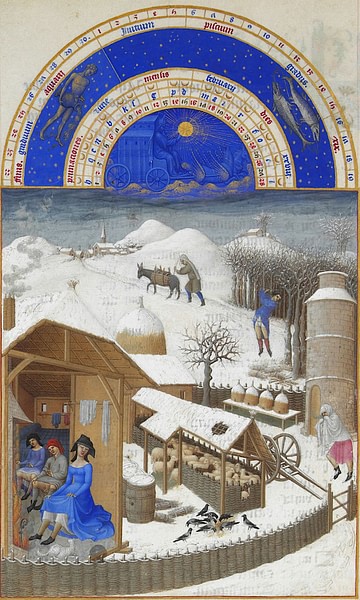
Serfs could not usually leave the estate on which they worked but the flip side was that they also had a right to live on it which gave them both physical protection and sustenance – a lord, no matter how rapacious, would not benefit from starving the labourers who worked his own lands. A serf inherited the status of their parents, although, in the case of a mixed marriage (between free and unfree labourers), the child usually inherited the status of the father. A landowner could sell one of his serfs but the right for sale was that of labour, not direct ownership of the person as in slavery. Theoretically, the personal property of a serf and his simple thatched house of mud and straw all belonged to the landowner but this was unlikely to have been enforced or to have had any relevance in practical terms. Aside from payment of a regular percentage of the foodstuffs produced on their own land, a serf was obliged to pay fines and certain customary fees to their lord such as on the marriage of the lord's eldest daughter, or at the death of a serf in the form of an inheritance tax paid by the serf's heir.
Serfs did get to live it up a little once a year when, by tradition, they were invited to the manor on Christmas day for a meal. Unfortunately, they had to bring along their own plates and firewood, and of course, all the food had been produced by themselves anyway, but it was at least a chance to see how the other half lived and relieve the drearieness of a country winter.
Free Labourers
A minority of labourers on an estate were not serfs but freemen. Their situation was not vastly different from the serfs' in economic terms although they could (but not always) own freehold land (i.e. they were permanent owners) and they were not subject to the fees and restrictions that a serf was. Free labourers often paid rent instead of giving labour to work their lord's demesne, which was typically paid in produce form their own land. The land they could call their own was usually small and so it was often necessary for these peasants to hire out their labour to supplement their income. Free labourers might also be permitted, with their lord's consent, to sell their tenancy to a third party. Only about one-fifth of the free peasantry had enough land (around 20 acres minimum) to produce a surplus beyond their own family's needs and they often did not have the best land for agriculture (the lord had that). Their lot was a precarious one and a single bad harvest or lengthy illness could mean a free labourer was obliged to become a serf.
Cottagers
Another type of peasant was the cottager or cotter who could be free or unfree and who owned little or no land of their own but rented a cottage. They usually performed odd-jobs as needed, helping on manor estates with such tasks as threshing, sheep-shearing, collecting hay or simply digging and weeding.
Manor Courts
The manor had its own court run by the lord or his steward. In England, such a court, held in the great hall of a castle or manor, was known as a hallmote or halimote. Disputes between members of the manor estate on such things as the right to use particular areas of land like woodlands or peat lands (but not disputes between the lord and an individual peasant) were dealt with here, as well as the fines imposed on the estate workers and any criminal matters. Serious crimes such as murder were judged in the courts of the Crown. The hallmote may have been biased toward the landowner but there were higher courts to appeal to and records show that the peasantry, acting collectively, could bring cases against a landowner.
Decline in Manorialism
The systems of both feudalism and manorialism were weakened by several developments in the late Middle Ages. One particular blow came from the sudden population declines caused by wars and plagues, particularly the Black Death (which peaked between 1347-1352). Another frequent risk to everyone's livelihood was crop failures. Such crises caused a chronic shortage of labour and the abandonment of estates because there was no one to work them. The growth of large towns and cities also saw labour leave the countryside to find a better future and the new jobs available there working for the new and wealthy merchant class.
Those serfs who remained on estates gradually increased their political power by acting collectively in village communities which began to hold their own courts and which acted as a counterweight to those of the landed gentry. There were sometimes serious revolts by the peasantry against their masters. The years 1227 in the northern Low Countries, 1230 on the lower Weser in northern Germany and 1315 in the Swiss Alps, all witnessed violent peasant armies getting the better of those involving aristocratic knights, and a major but unsuccessful rebellion, the Peasants' Revolt, occurred in England in 1381.
Finally, the increase in the use of coinage in the late Middle Ages meant that many serfs made a payment to their lord instead of labour, or paid a fee to be absolved from some of the labour expected of them, or even bought their freedom. Across Europe, all of these factors conspired to weaken the traditional set up of unfree labourers being tied to the land and working for the rich so that by the end of the 14th century, more agricultural labour was done by paid workers than unpaid serfs.

